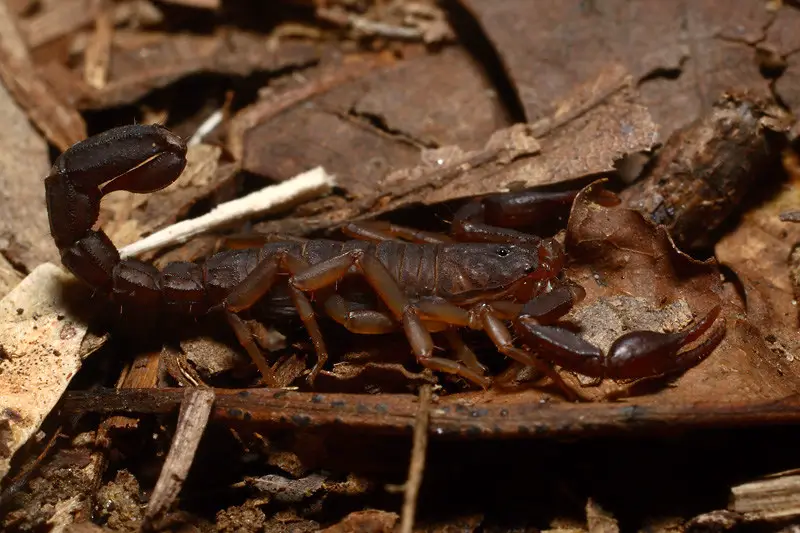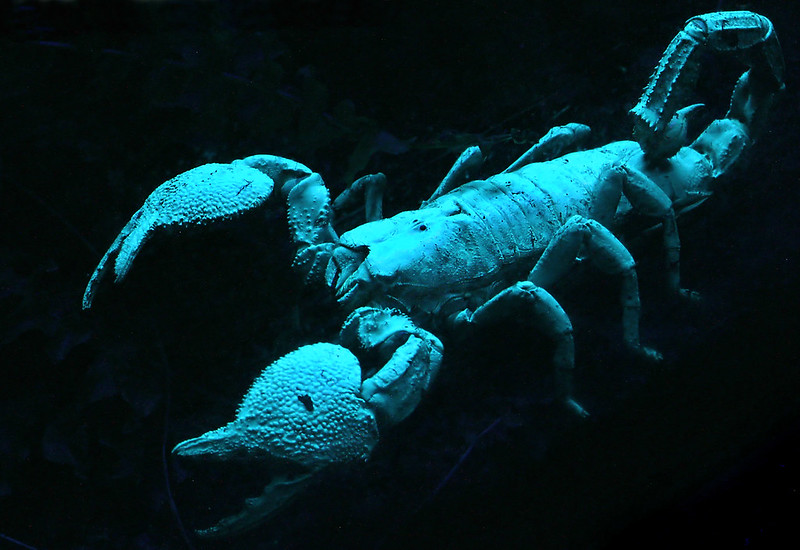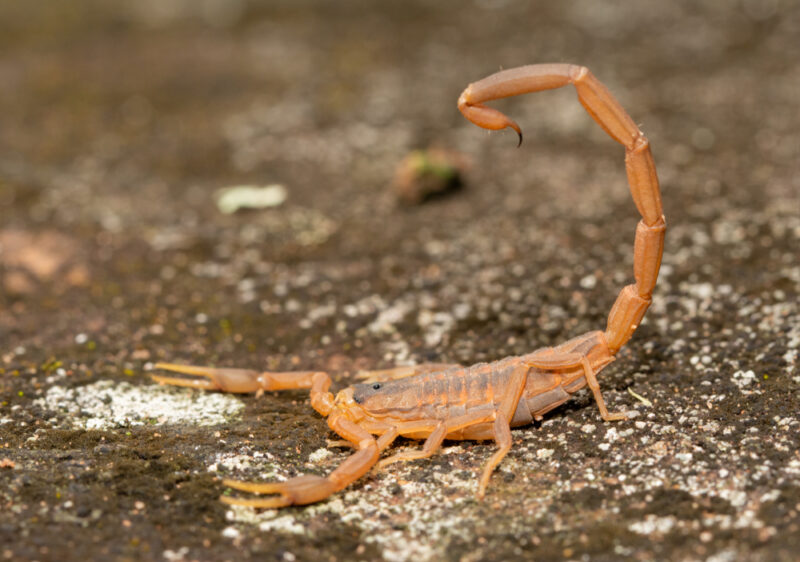Tennessee is home to two types of scorpions. These are the Southern Unstriped Scorpion or Southern Devil Scorpion and the Striped Bark Scorpion. Of these two, the only native scorpions to the state are Southern Unstriped Scorpions. The Striped scorpion is not native to Tennessee. At some point, it was accidentally introduced to the state. See Accidental introductions of species happen when the “in this case, scorpion”, hitches a ride into the area on goods from other states.
The good news about Striped Bark Scorpions and Southern Unstriped Scorpions is that they have stings that are no more medically significant than a bee sting. At the same time, in rare cases, any scorpion’s sting has the potential to cause a severe allergic reaction. Serious symptoms such as anaphylactic shock are a possibility. If you have blurred vision, muscle spasms, or difficulty breathing after experiencing a scorpion sting, seek immediate medical attention.
Tennessee is also home to a tiny arachnid species called pseudoscorpions. Pseudoscorpions are not true scorpions, but they do look similar to a tiny scorpion minus the stinger. Since they have some physical similarities and share the name scorpion, we’ll take a closer look at them in the paragraphs below, along with Tennessee’s Southern Unstriped Scorpions and Striped Scorpions.

Southern Unstriped Scorpion (Vaejovis carolinianus)
The Southern Unstriped Scorpion goes by several different common names. People use them interchangeably, depending on the locality. Besides Southern Unstriped Scorpions, they are also called Southern Devil Scorpions, Carolina Devil Scorpions, and Plain Eastern Stripeless Scorpions.
Where do Southern Unstriped Scorpions Live?
People associate scorpions with the dry arid desert areas of the western United States. However, there are also types of scorpions that are native to warm, moist areas such as the southeastern states. The Southern Devil Scorpion is one of these.
Besides Tennessee, it is native to all or parts of North Carolina, South Carolina, Florida, Georgia, Louisiana, Virginia, West Virginia, Alabama, and Mississippi.
How Dangerous are Southern Unstriped Scorpions?
To quote University of Tennessee entomologist Karen Vail, “The Unstriped Scorpion is tiny, and its sting is usually harmless, but some people may have an allergic reaction to the venom if stung.” See
These scorpions pack a painful sting. Nevertheless, the venom of this species is not medically dangerous to normal healthy individuals. People who have been stung by one report that the pain intensity is very similar to a wasp sting.
However, as stated in the opening section, all scorpion stings have the potential to cause severe allergic reactions in some people. Here is the account of James Scully, who was a corporal in the 6th New York Cavalry of the Union Army during the Civil War. While encamped at Fair Oaks, Virginia, in 1862, Corporal Scully suffered a scorpion sting to the back of his neck and nearly died due to the severity of the reaction it produced.
Just like in Tennessee, the only native scorpion in the state of Virginia is Vaejovis carolinianus, or common name, the Southern Unstriped Scorpion.
What do Southern Unstriped Scorpions look like?
All scorpions look a little bit like tiny land-dwelling lobsters with some distinctions. Lobsters have 10 legs, while scorpions have 8, and of course, lobsters don’t have a bulbous venom-filled stinger on the end of a narrow tail, while scorpions do.
Southern Devil Scorpion adults are typically 1 to 1 1/2 inches in length. However, larger specimens grow up to three inches long. In color, they have either a reddish or dark brown color.
Southern Unstriped Scorpion Behavior
Southern Devil Scorpions are nocturnal animals. During the day, they take shelter under loose stones, under loose bark, and beneath forest litter such as leaves and sticks.
Around your house, you might encounter these little scorpions in a crawl space, beneath leaf piles or wood piles, in laundry rooms, or even inside one of the garden gloves that you accidentally left outside overnight. If you’re camping in their native areas, be sure to double-check your shoes, your sleeping bag, clothing, and any other possible hiding place that these scorpions might utilize. Luckily, they are very skittish and would rather hide from you than sting you. The only way you’ll ever be stung by one is through accidental contact.
They only use their stinger for defense or to subdue their prey. Their prey, by the way, consists of small insects and arachnids, such as spiders and other scorpions.

Common Striped Bark Scorpion (Centruroides vittatus)
Striped Bark Scorpions, which also go by the common names Plains Scorpion, Wood Scorpion, or Stripe Backed Scorpion. Common Striped Bark Scorpions are the most common species of scorpions in the United States. Thousands of people are stung by them each year when they step on them with bare feet or come into accidental contact with them in some other manner.
How dangerous are Striped Bark Scorpions?
According to the book, “The Biology of Scorpions” by Gary A. Polis, there are over 1,500 species of scorpions in the world. Of these, fewer than 25 have stings that are lethal to humans. What’s more, all of the most deadly scorpions are members of the Buthidae family. For example, in North America, we have the Arizona Bark Scorpion. This buthid scorpion lives in the southwestern United States and northern Mexico and is on the list of deadliest scorpions.
Striped Bark Scorpions are also members of the Buthidae family. However, their sting is not nearly as dangerous as that of their close relatives. Instead, it is more on par with the seriousness of the sting of a honeybee. It’s important to remember, though, that as with the Southern Unstriped Scorpion, even though Striped Back Scorpion stings are fairly innocuous to most people, in certain individuals, they can produce severe symptoms.
Where do Striped Bark Scorpions Live?
Striped Bark Scorpions live in a variety of environments, such as woodland, grassland, and desert. During the day, they will take shelter in a variety of hiding places, such as under loose stones, beneath loose bark, or in wood stacks, etcetera.
The range of the Striped Back Scorpion begins in the northern Mexico states of Chihuahua, Coahuila, Nuevo Leon, and Tamaulipas. It then extends northward up to the southern counties of Nebraska. Their range also extends longitudinally from the Sangre de Cristo mountains and Rio Grande of New Mexico in the west and the Missouri River and the Mississippi River in the east. The following U.S. states have populations of Striped Bark Scorpions: Arkansas, Colorado, Kansas, Illinois, Louisiana, Mississippi, Missouri, Nebraska, New Mexico, Oklahoma, Florida, Georgia, and Texas.
In areas with colder wintertime temperatures, Striped Bark Scorpions survive by tolerating limited freezing of their body tissue. These scorpions then hibernate through the months of cold weather in clusters of multiple scorpions.
What do Striped Bark Scorpions look like?
Like Southern Devil Scorpions, Striped Bark Scorpions look a little bit like tiny land lobsters.
Adult Striped Bark Scorpions are up to 2 3/4″ long. An adult of this species is uniformly pale yellow in color, with the exception of two longitudinal dark stripes that run the length of its back and a dark triangle at the top of its head.
Striped Bark Scorpion Behavior
Unlike Northern Scorpions and Northern Black Hairy Scorpions, which never venture far from their burrows, Striped Bark Scorpions are wandering nocturnal hunters. Like all bark scorpions, they are natural climbers. Besides living under rocks, they climb trees and fence posts and have no problem climbing the walls of your home. They actually have a negative geotaxis, or in other words, they prefer an upside-down orientation. See
Scorpion Reproductive Behavior
The mating behavior of most scorpion species is quite similar, so this section will suffice for both of Tennessee’s scorpion species.
Scorpions mate in the fall and also occasionally in spring or early summer. The mating process begins with the male engaging the female scorpion in an elaborate mating dance called the promenade a deux. At this time, the male maneuvers the female to a spot where he can deposit a sperm packet called a spermatophore for her reception.
The male must hold the female over the spermatophore long enough for her to receive it. Therefore, larger males successfully mate a larger percentage of the time. If the female accepts the male’s spermatophore, the pair join together and rub chelicera in the “kiss” stage. At this point, the female takes up the spermatophore. From there, things become dicey for a large percentage of males. The male must figure out how to disengage and escape from the larger female. Once again, according to the book The Biology of Scorpions, in around 39% of scorpion species, post-mating cannibalism occurs.
What follows is about an 8-month gestation, after which their offspring are born alive.
After the newborn scorpions free themselves from the birth membrane, they will climb up their mother’s walking legs and onto her back. The females of both species of Tennessee scorpions carry their young on their backs. The young scorpions ride there on their mother’s back in a grouped formation, only climbing down to feed on pellets that the female scorpions create for them when she feeds until they are sufficiently old to strike out on their own. This is generally after their first molt. See

How to look for Scorpions
As stated above, during the day, these scorpions hide out. Crawl spaces, wood stacks, rocky hillsides, and leaf-covered areas are all examples of likely hiding spots.
Scorpions have compounds in their exoskeletons that glow under black light. To see them after dark, in your yard, or if you are camping in an area where scorpions are active, the best way to find them is with a UV flashlight. Use the ultraviolet light to scan your yard or campsite after dark. The scorpions will glow a bright blueish color.
Remember that the darker the night, the more the scorpion will glow. In other words, they are more luminous on a night of a new moon, for example. What’s more, campfires and other sources of light will cut down on the effectiveness of your ultraviolet light source.
One last thing to remember on this subject is that UV light radiating in the 320 to 400 nm range isn’t overly harmful to your vision. However, if you choose to use a UV light source that produces shorter wavelengths, you’ll want to also use eye protection.
Fun Fact
Even fossilized scorpions glow under ultraviolet light.

Pseudoscorpions in Tennessee
Pseudoscorpions also have the common names of Book Scorpion or False Scorpion. These little creatures look a lot like a tiny scorpion minus the stinger. They have a flat, pear-shaped body, eight legs, and a pair of proportionately large pinchers or pedipalps, just like scorpions. However, although they share some similarities, they are not actual scorpions.
They are arachnids, though, which means they are related to spiders, scorpions, mites, and ticks. In fact, minus their proportionately large pincers, false scorpions look a lot like ticks.
People also sometimes mistake these tiny little creatures for ticks. There are over 3,300 pseudoscorpion species worldwide, and their average body length is just 3 millimeters.
Pseudoscorpions live in cracks and crevasses as well as in leaf litter and underneath tree bark in the outdoors. They will make their way inside people’s homes occasionally. However, they are not a threat to humans.
Book Scorpions don’t have a stinger on their tail. However, they do have a stinger in each pincher. They inject their prey with venom to immobilize it. After which, they secrete a fluid over it to dissolve it so that they can ingest the liquified remains.
These tiny arachnids spin silk that they secrete from glands in their jaws. They use this silk to construct cocoons for the purposes of mating, molting, or taking shelter during the winter months.
Book Scorpions are generally beneficial to humans since they prey on pests such as clothes moth larvae, carpet beetle larvae, booklice, ants, mites, and small flies. See
You may also like:
Recent Posts
The only venomous snakes in Washington State are Northern Pacific Rattlesnakes. The Northern Pacific Rattlesnake (Crotalus oreganus oreganus) is a sub-species of the Western Rattlesnake. Anyone...
Skunks are not classified as true hibernators. But they go into a state of torpor when the weather gets cold. Skunks are light sleep hibernators, along with opossums, bears, and raccoons. ...

